LIGHTING
A preliminary estimate of the number of incandescent lamps sold in the United States during 1931 (Fig. 177) indicates a total of 557,400,000 for both large and miniature lamps. The figures in the chart for the last three years include the sales of carbon lamps, the use of which is evidently diminishing rapidly for, whereas in 1929 the total was slightly under 31,000,000, in 1930 it had been reduced to about 17,000,000, and the estimates for 1931 bring the figures below the 5,000,000 mark.
New Lamps
A 5-watt lamp (Fig. 178) was produced to meet the demand for a small standard 115-volt lamp to be used in the lighting of ornaments and signaling devices. The rated light output of this lamp is greater than that of the carbon lamps heretofore used for illumination of this kind and its design life is 1500-hour.
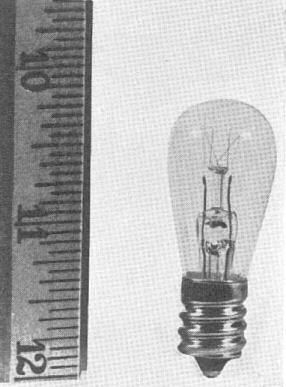
Fig.178 Five-watt lamp
It is the lowest-wattage tungsten-filament lamp that has so far been made commercially available for standard voltages. The 40-watt lamp was changed over from the vacuum type to the gas-filled type, giving it an average of six per cent more light throughout its rated life of 1000 hours. The change also made it possible to reduce the size of the bulb (Fig. 179) and it gives a whiter light than its vacuum-type predecessor.
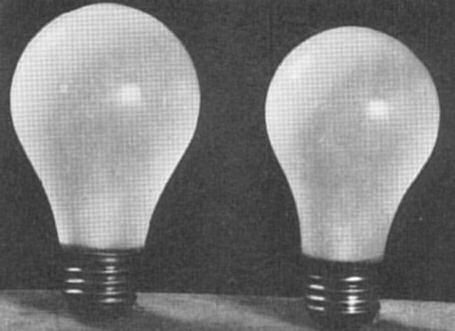
Fig.179 The 40-watt Lamp: Vacuum type at left,
New gas filled type at right
A new 30-watt lamp (Fig. 180) was designed primarily for decorative service, being outside spray coated in white, ivory, flame-tint, rose, or red. It is, however, a highly efficient light source as it is inside frosted and has a design life of 600 hr. for operation on 115 and 120-volt circuits.
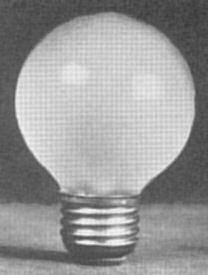
Fig.180 New 30-watt Lamp for decorative service
A new 10,000-watt lamp (Fig. 181) exemplifies the progress made during the year in the development; of higher-wattage lamps. The tungsten filament is wound on a smaller mandrel and consists of eight segments instead of the six used in previous types of this rating. This results in a more concentrated light source with less sag as the filament is burned. In the new lamp, a copper-thimble seal is used, which does away with the lead-in wire passing through the glass, thus eliminating the danger of the glass cracking from the high temperature of the wire. The bulb is larger than before and the lamp is cooler when operating, so that mechanical failures heretofore caused by over-heating are avoided. The new bulb is made of Pyrex glass. These combined changes in structure and material have produced a notable in- crease in the candle-power of the projected beam and the new lamp is mechanically better than its predecessor.
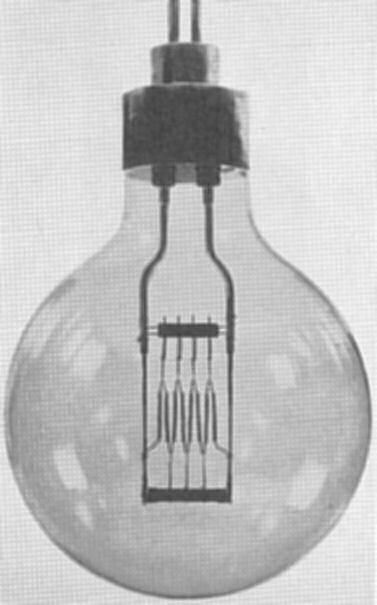
Fig.181 New 10,000 watt lamp showing filament structure
Tubular Lamps
Modern architectural demands resulted in the production of a 150-watt tubular lamp (Fig. 182), 11 7/8 in. long and 1 1/4 in. in diameter, with a medium- screw base. The nine-inch filament gives a lineal light source of uniform intensity for the illumination of glass panels, luminous columns, art galleries, display cases, etc. It can also be used in cove lighting, show windows, and various types of lighting fixtures requiring an elongated light source. A 100-watt lamp of this type, 34 in. long and 1 1/2 in. in diameter, was developed for use in counter and window signs and in modern types of luminaries. This lamp may be burned in any position if properly supported.

Fig.182 150-watt tubular lamp
Projection Lamps
A 300-watt 115-volt lamp with monoplane filament was made available for 16-mm. projectors. The advantages of this new lamp are that it does away with the necessity for rheostats or transformers and makes the projector usable on either ac or dc circuits. It has the same physical dimensions as the 250-watt 50-volt and 20-volt lamps now generally used, and therefore can be applied in equipments using the older lamps with no other change than altering the electrical connections.
Water-cooled Lamp
A new water-cooled lamp (Fig. 183) was developed which consists of an outer glass globe over the Mazda lamp with the space between filled with distilled water or another suitable liquid. Near the top of the outer glass globe and immersed in the liquid is a cooling coil through which ordinary tap water circulates. The unit is operated with the lamp vertical, base up. A large part of the heat is removed by the cooling system, and only a small amount of light is lost. It was designed for service in locations where it is desirable that convected and radiated heat be avoided as much as possible, such as in hospital operating rooms; opaque projection; photographic lighting, printing, and enlarging; show-window lighting; refrigerators; and any location where heat from the lamp has a deleterious effect.
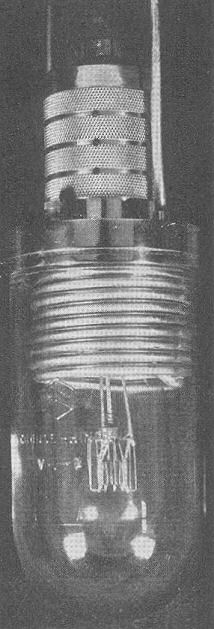
Fig.183 Water-cooled lamp showing arrangement of cooling coil
Vapor Lamps
The new windowless factory of the Simonds Saw and Steel Company in Fitchburg ( Mass. ), is lighted by 680 special combination mercury and incandescent lamp units. Each consists (Fig. 184) of a rectangular shaped housing and a 50-in. mercury-vapor tube in the shape of a "U" with four 75-watt 30-volt incandescent lamps in a row between the parallel sides of the "U" tube. The unit takes a total load of 650 watts: 300 for the lamps, 300 for the tube, and 50 for the auxiliaries. This wattage produces initially about 9000 downward lumens and the resulting light closely approximates daylight. The units are mounted at a height of 16 ft., are spaced on 14 by 20-ft. centers, and provide approximately 28 ft-cd the working plane. An 850-watt mercury incandescent unit, using eight 110-volt 50-watt lamps in line above a straight mercury-vapor tube was designed for general industrial use. Except for the reflector, standard parts are used in the new assembly.
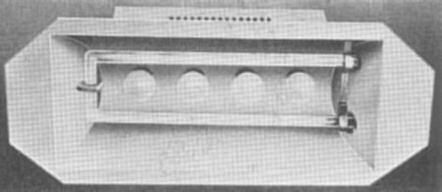
Fig.184 Combination mercury and incandescent lamp unit
The standard industrial unit was redesigned (Fig.185) to incorporate improvements in lamp starting and to provide increased electrical insulation, lamp protection, and better appearance. The electrical circuit of the new alternating-current lamp is the familiar full-wave rectifier circuit previously used with the addition of a small copper-oxide rectifier to supply direct current for the starting circuit.
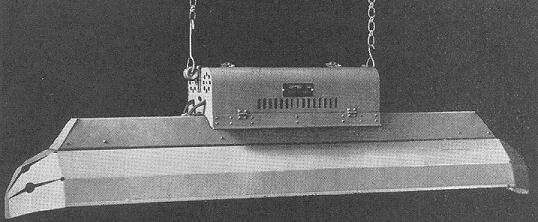
Fig.185 Combination mercury-incandescent industrial lighting unit
Alternating-current neon positive-glow lamps (Fig.186A) of 2 to 5-watt 110-volt rating were designed for low intensity sign and location indicator use. The source is a glowing column of gas five inches long by one-half inch diameter. Direct-current, negative-glow neon lamps (Fig.186B) of 2 to 5-watt 110-volt rating were developed for sign and position indicator use. The source is a circular disk one inch in diameter. This lamp is also useful as a visual polarity indicator as there is practically no visible glow on incorrect polarity. A new current-indicating negative-glow neon lamp (Fig. 186C) is intended for use as a visual milliammeter, 0.5 to 5.0 milliamperes, and in series with fixed resistance, as a visual voltmeter. It gives indication by the linear extent of the glow along a straight grooved electrode.
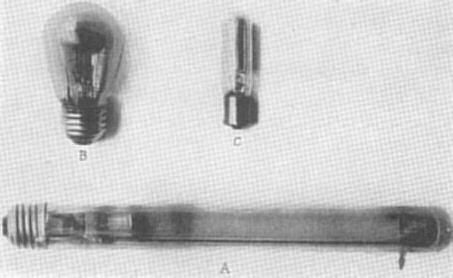
Fig.186 Gaseous glow lamps
Ultraviolet Lamps
Developments of major importance in the field of ultraviolet-producing lamps (Fig. 187) consisted primarily of improvements in the Type S-1 Sunlight lamp, and the production of the Type S-2 Sunlight lamp, the CX lamps, and the glow lamp. The clear bulbs first used with the Type S-1 lamps were replaced by inside frosted bulbs. As in other lamps used in general lighting, this reduces glare with very little loss of ultraviolet output or alteration of illumination distribution. The Type S-2 lamp is similar in design and performance to the Type S-1 lamp, having a tungsten filament for starting, a mercury-vapor arc between two electrodes for the production of ultraviolet radiation, and a special clear-glass bulb which transmits the biologically effective ultraviolet radiation but absorbs the shorter wavelengths harmful to the eyes. A small amount of mercury in the bulb furnishes the mercury vapor for the generation of the ultraviolet radiation.
New features making this lamp an efficient producer of ultraviolet are an increased arc length, and an oxidized aluminum cap placed over the lower portion of the bulb, which increases the operating temperature and the ultraviolet radiation, and at the same time minimizes glare. The lamp, which operates with a small specially designed autotransformer, has a new base slightly larger than the medium screw size to guard against its being placed in a standard socket. About one-half the ultraviolet radiation of the Type S-1 lamp is produced, but only 40 per cent of the wattage of the Type S-1 is consumed.
The 60, 300, and 500-watt CX lamps are low sources of ultraviolet radiation developed for use particularly in animal and poultry husbandry where animals and birds can be kept close to them for long periods of exposure, and for experimental use. They have inside-frosted bulbs of special glass and their incandescent tungsten filaments operate at somewhat higher temperatures than those of standard lamps of corresponding wattage.
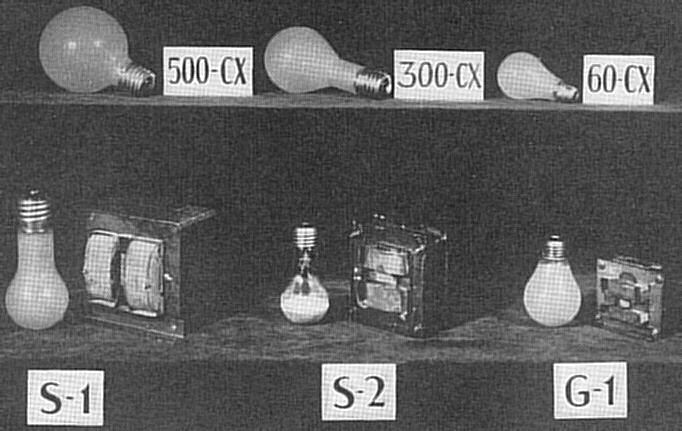
Fig.187 Ultraviolet producing lamps
They are supplied for standard lighting service voltages and do not require transformers for operation. Their ultraviolet outputs compared to the Type S-1 lamp are approximately 0.7 per cent, 4% per cent, and 8 per cent respectively for the 60, 300, and 500-watt sizes.
The glow lamp or Type G-1 consists of two oxide- coated tubular electrodes, heated from within by tungsten filaments, and a pool of mercury. A mercury arc operates between these electrodes and the discharge extends throughout the mercury vapor which fills the bulb. This lamp is of relatively low brilliancy. The ultraviolet radiation comes from the entire bulb area rather than from the arc between the two electrodes. The inside-frosted bulb is made of special glass. The lamp operates with a small transformer and has a medium screw base. Approximately 50 watts are consumed by the Type G-1 lamp, which produces about one-sixteenth of the amount of biologically effective radiation obtained from the S-1 lamp and about one-eighth of that obtained from the S-2 lamp.
The lamp operates with a small transformer and has a medium screw base. Approximately 50 watts are consumed by the Type G-1 lamp, which produces about one-sixteenth of the amount of biologically effective radiation obtained from the S-1 lamp and about one-eighth of that obtained from the S-2 lamp.
Dual-purpose Lighting
New dual-purpose lighting units using regular Mazda lamps as well as the Sunlight lamps were developed to give beneficial ultraviolet radiation for health maintenance in combination with illumination for seeing without interfering with the daily work of those exposed. The relatively small size of the new Type S-2 lamp permitted the production of equipments more compact in design and of lower cost than those using the earlier type Sunlight lamp. Dual- purpose lighting, therefore, is now available for the many types of areas to be lighted, and the new units are particularly well adapted for use in such places as the home, the office, and the recreational area. The Uviarcs, mercury arcs in quartz as sources of ultraviolet radiation, were improved as to their rate of depreciation by the use of large molybdenum anodes operating at a much lower temperature than is characteristic of the small tungsten anodes formerly used.











